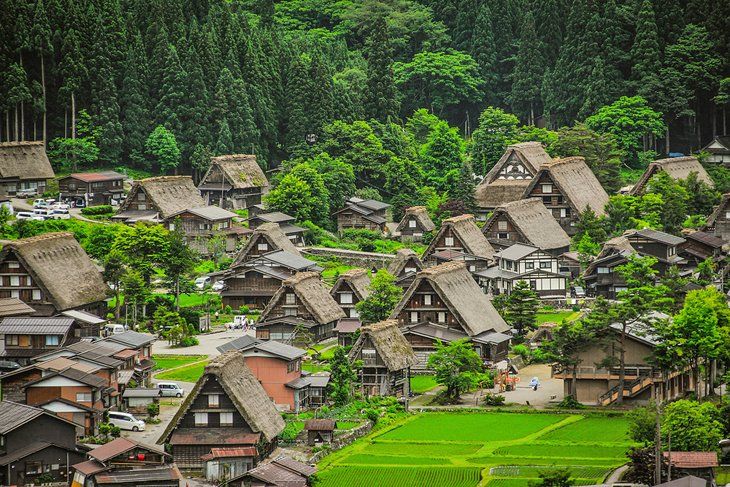
Hidden in the mountainous Gifu Prefecture of central Japan lies a village that transforms into a winter wonderland so magical it earned snow-covered village UNESCO World Heritage status. Shirakawa-go, with its distinctive traditional farmhouses and heavy snowfall, offers visitors a glimpse into Japan’s rural past while showcasing human adaptation to some of the harshest winter conditions in the country.
A Village Shaped by Snow

Shirakawa-go receives some of Japan’s heaviest snowfall, with winter accumulations regularly reaching depths of 10 feet (3 meters). This extreme environment shaped both the architecture and way of life in this isolated mountain community. The village records show snowfall averaging 415 inches (10.5 meters) annually, making it one of the snowiest inhabited places in Japan.
The most striking feature of Shirakawa-go is its collection of farmhouses built in the gassho-zukuri style. “Gassho-zukuri” translates to “constructed like hands in prayer,” referring to the steeply pitched thatched roofs that resemble Buddhist monks’ hands pressed together in prayer. These roofs aren’t just architecturally distinctive, they’re ingeniously designed to prevent collapse under massive snow loads.
Key features of these unique structures include:
- Roofs pitched at 60-degree angles to shed heavy snow
- Thatched roofs made from susuki grass that can last 30-40 years
- No nails were used in the roof construction, only intricately tied ropes
- Multi-story designs with open attics for silkworm cultivation
- East-west orientation to minimize wind impact and maximize sunlight
The largest of these farmhouses, known as Wada House, measures over 3,300 square feet and stands as a museum today. Many structures in the village date back more than 250 years, with some believed to be over 300 years old.
Living Heritage and Cultural Adaptation

Shirakawa-go isn’t just an architectural marvel, it represents centuries of cultural adaptation to geographic isolation and extreme weather. Until a road connected the village to nearby cities in 1925, the community was largely cut off during the winter months.
This isolation fostered unique cultural practices and a strong spirit of cooperation. One tradition that continues today is called “yui,” a system where families help each other re-thatch roofs on a rotating basis. This community effort typically involves 35-40 people working together for several days.
The village maintained its distinctive character partly because of its remoteness. Even today, Shirakawa-go has only about 1,600 residents. Tourism now plays a vital role in the local economy, with the village attracting over 1.8 million visitors annually, according to recent tourism data.
Winter Illumination Events

While beautiful year-round, Shirakawa-go reaches peak visitation during special winter illumination events held several times between January and February. During these events, the entire village is lit up against the snowy landscape, creating a scene reminiscent of a fairy tale.
The illuminations typically occur from 5:30 PM to 7:30 PM on selected dates and draw thousands of photographers and winter travelers. Reservations for these events often fill months in advance, with visitors coming from across Japan and internationally.
Temperature data shows evening temperatures during these events regularly drop to 23°F (-5°C) or lower, adding to the atmospheric winter experience but requiring visitors to dress appropriately.
Preservation Challenges

Maintaining Shirakawa-go as a living heritage site presents unique challenges. The village received snow-covered village UNESCO status in 1995, bringing international recognition but also increasing tourism pressure.
Conservation statistics reveal some concerning trends:
- The number of original gassho-zukuri houses has decreased from 93 in 1994 to approximately 59 today
- Traditional thatching skills are practiced by a declining number of craftspeople
- Climate change has begun altering historical snowfall patterns
- Balancing modern amenities with historical preservation remains difficult
Local authorities have implemented visitor management systems and educational programs to help preserve the village’s unique character while allowing sustainable tourism.
Planning a Visit
The best time to experience Shirakawa-go’s winter beauty is from December through February, with January typically offering the most reliable heavy snowfall. The village is accessible by bus from nearby cities, including Takayama, Kanazawa, and Nagoya.
For those planning to witness the famous winter light-up events, advance reservations are essential, as these limited events sell out quickly. Tourism authorities recommend booking accommodations at least six months in advance for winter visits.
Several farmhouses in the village operate as minshuku (traditional Japanese guesthouses), allowing visitors to experience rural Japanese hospitality firsthand and wake up to pristine snow-covered views.
Have you ever visited a place where traditional architecture evolved specifically to handle extreme weather conditions? What intrigues you most about how communities adapt to challenging environments? Share your thoughts or experiences in the comments below. For those fascinated by UNESCO World Heritage sites or Japanese cultural traditions, browse our other articles exploring these remarkable places that preserve human history and ingenuity.




